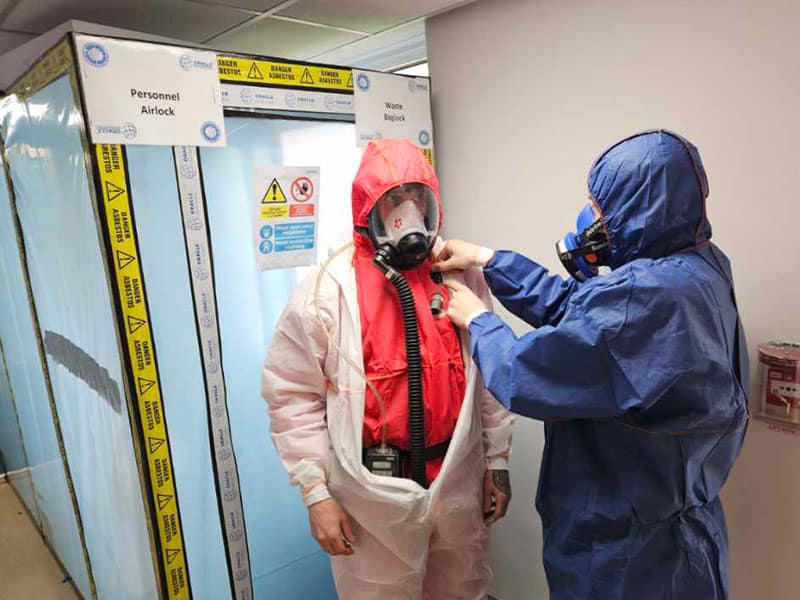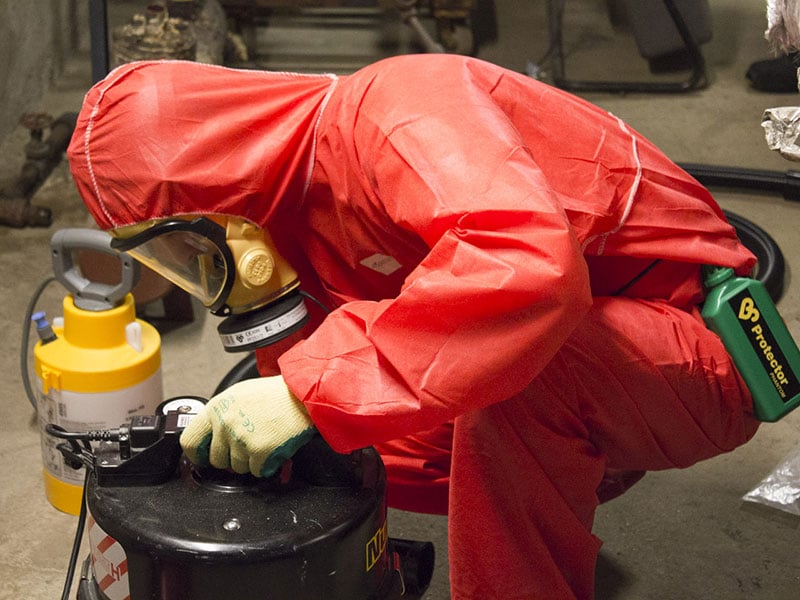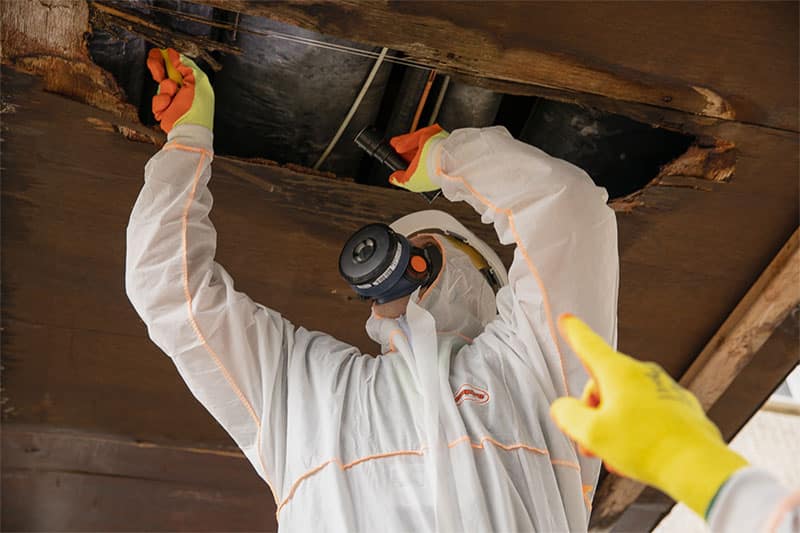What personal protective equipment should be used for licensed asbestos removal?
Asbestos is an incredibly dangerous material when it’s disturbed or damaged. Even if an asbestos-containing material (ACM) is in an undamaged state when work begins, it can become damaged while asbestos removal, building renovations, or other types of projects take place.
When asbestos is disturbed, it can release microscopic fibres into the air. When inhaled or ingested, those fibres can stick to the lungs and cause serious, life-threatening diseases years in the future.
Personal protective equipment (PPE) is worn on asbestos job sites to prevent workers from inhaling the fibres, spreading them around, and generally putting themselves and others at risk.

Why is PPE critical for safe asbestos removal?
Inhaling any amount of asbestos fibres can result in serious health complications 10 to 40 years in the future. This includes asbestosis, mesothelioma, lung cancer, and pleural thickening. Asbestos exposure can also increase the chances of developing other types of cancer, including colon cancer.
PPE lowers the chance of asbestos exposure because materials are purposely designed to prevent fibres from passing through. That means the fibres won’t be able to reach the person to be inhaled, and fibres won’t contaminate the clothing worn under the PPE, either.
Additionally, a lot of PPE is disposable, which eliminates the potential of fibre spread when worn off the job site or when washed and dried in laundry appliances. Disposable PPE can cover a worker from head to toe with head and foot coverings as well as coveralls.
According to the Control of Asbestos Regulations 2012 and the Health and Safety Executive (HSE), if an employee could become exposed to asbestos, the employer must provide the necessary PPE to keep them safe. Part of an asbestos risk assessment includes determining if and what type of PPE is needed. Additionally, all workers must be trained to properly use PPE and spot any faults that need to be reported.
What constitutes comprehensive PPE for asbestos removal?
The HSE outlines the different types of PPE and respiratory protective equipment (RPE) that may be needed when working with asbestos. Many items are disposable so they can carefully be thrown out with other asbestos waste and by following the same precautions as asbestos waste disposal.
Overalls
Disposable overalls — specifically Type 5 — should be worn. For certain types of work, like work that takes place outdoors, coveralls may need to be waterproof.
To prevent the coveralls from ripping, which could result in an exposure event, they should be one size larger than the individual needs. If that makes the cuffs too loose, they can be sealed with tape to keep asbestos fibres from getting into the coveralls.
Since coveralls are worn over the worker’s regular clothes, it’s best to wear a short-sleeved shirt or sleeveless shirt; a long-sleeved shirt can be too difficult to fully cover with the overalls. The hood of the overalls should go over, not under, the straps of the RPE.
The legs of the overalls should be worn over footwear instead of tucked into the footwear. If the legs were to tuck into the footwear, that could cause asbestos fibres to get inside the footwear.
Gloves and footwear
Any gloves worn during an asbestos project should be single-use and disposable. If latex gloves are to be worn, they should be low-protein and powder-free.
Unlike other types of PPE, footwear should not be disposable, as disposable footwear can make it easier to slip. Boots without laces should be worn because they’re easiest to clean. It’s also easier to cover boots with overalls than shoes or sneakers that start lower on the ankle. Boot covers may also be worn.
Respiratory protective equipment
RPE is a type of PPE. According to the HSE, RPE used in asbestos work must have “a UK-assigned protection factor (APF) of 20 or more.” Acceptable types of RPE include:
- Disposable respirator: EN 149 / type FFP3 or EN 1827 / type FMP3
- Half-mask respirator (EN 140) with a P3 filter
- Semi-disposable respirator (EN 405) with a P3 filter
It’s especially important that workers choose RPE that’s the right size for them and fits well. For workers with facial hair, hooded respirators may need to be worn instead of the basic equipment. However, it’s best that workers are freshly shaven so the RPE can seal correctly.
Eyewear
Certain types of respirators, like full-face respirators, will have built-in eyewear. Otherwise, eye protection is a necessary component of PPE when working with asbestos. While asbestos exposure that impacts the eyes may not result in serious disease, it can cause eye irritation and pain, along with other types of damage.
Safety goggles prevent fibres and other harmful particles, like debris from construction materials, from getting into the eye. Eyewear should be fitted after the RPE is fitted to ensure a tight seal. Note that the goggles should provide full coverage instead of safety glasses that are open on the sides.
How does respiratory protective equipment protect against asbestos?
As we discuss in our guide to asbestos RPE, each kind of RPE has an assigned protection factor (APF), which determines if the chosen RPE is suitable for the type of asbestos work and exposure risk that will take place. The minimum protection factor should never be below 20, which means that disposable respirators and respirator filters have to be a minimum of Filtering Facepiece 3 (FFP3). Also, the HSE recommends that RPE with an APF above the calculated value be chosen to ensure it offers complete protection.
In addition to selecting the right type of RPE for the asbestos work, the equipment has to fit properly to be effective. During face-fit testing, which can be conducted by the professionals at Oracle, it’s determined if any airborne particles are able to get inside the mask the subject is wearing, which would mean that there’s a break in the seal and it doesn’t adequately fit. During the test, the subject will go through various exercises, such as deep breathing, moving their head, and bending over, simulating the same movements they would likely make while on the job site.
What training is essential for the effective use of PPE in asbestos removal?
The United Kingdom Asbestos Training Association (UKATA) offers a Licensable Work With Asbestos training course for anyone who will be performing licensable work with ACMs. One of the training modules for this course covers PPE, while another covers RPE. There’s also a waste management and disposal module, and since some PPE and RPE become asbestos waste, this is important to learn about.
When taking any sort of asbestos training, it’s important to choose a reputable association like UKATA. Recognised as the leading association for asbestos training in the UK, UKATA regularly monitors and audits members to ensure all training provided is aligned with the HSE.
Conclusion: Embracing comprehensive protection with PPE
Working with asbestos is a highly dangerous job, whether or not the ACMs are damaged when the work begins. Any type of contact with an ACM has the potential to result in an exposure event. There’s no safe asbestos exposure incident, no matter how quickly it’s solved or how little asbestos is inhaled.
PPE and RPE protect asbestos workers from inhaling or ingesting toxic asbestos fibres, which can prevent life-threatening diseases from occurring in the future. Along with other control methods, like proper handling of ACMs and enclosing workspaces to prevent fibres from spreading, wearing the correct equipment can prevent exposure or reduce exposure as much as possible.
If you need help with asbestos compliance, selecting the right PPE and RPE, or RPE fit-testing, contact Oracle today.

Written by Jess Scott
Jess Scott has been an all-round asbestos consultant since 1996. That’s nearly 3 decades of asbestos knowledge. He spends his time sharing that knowledge with the team at Oracle and with their clients. Jess's goal is, and always has been, to use my expertise in helping people to comply with the law. This legal compliance ultimately helps to protect everyone from the harmful effects of asbestos. Jess has acted as an asbestos expert witness in legal cases and is involved in many asbestos educational activities throughout the UK.


